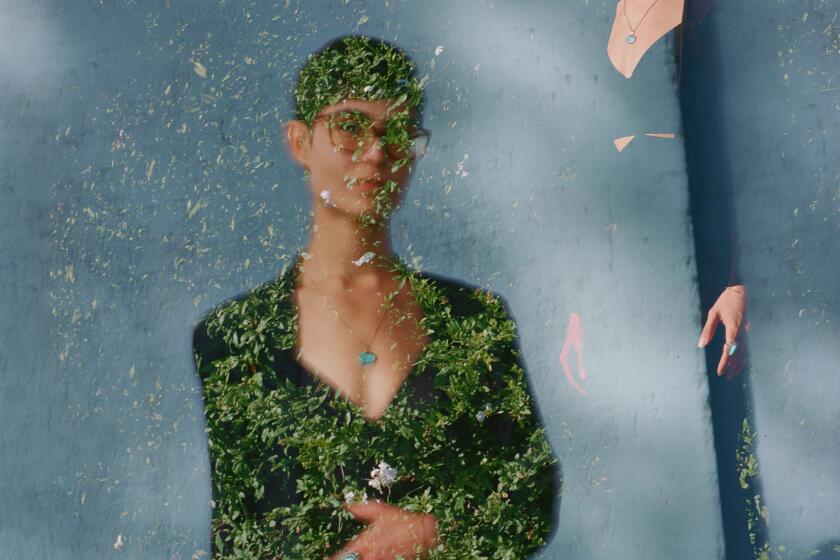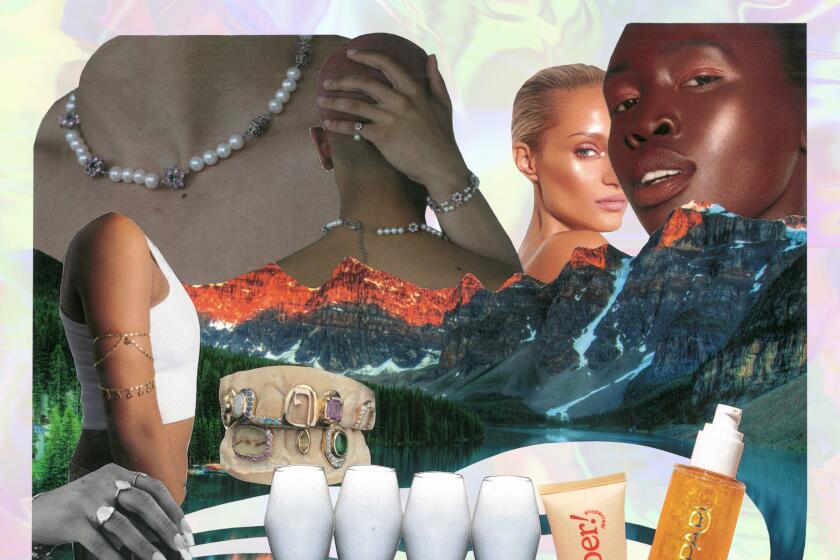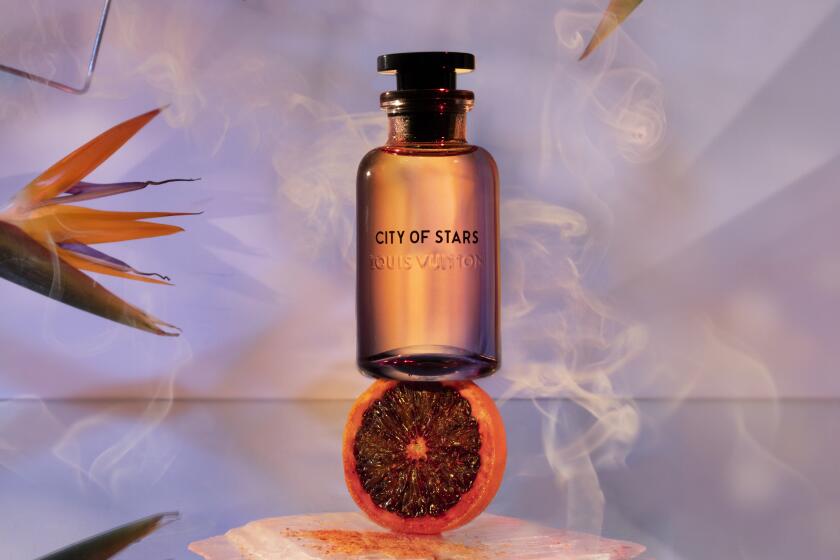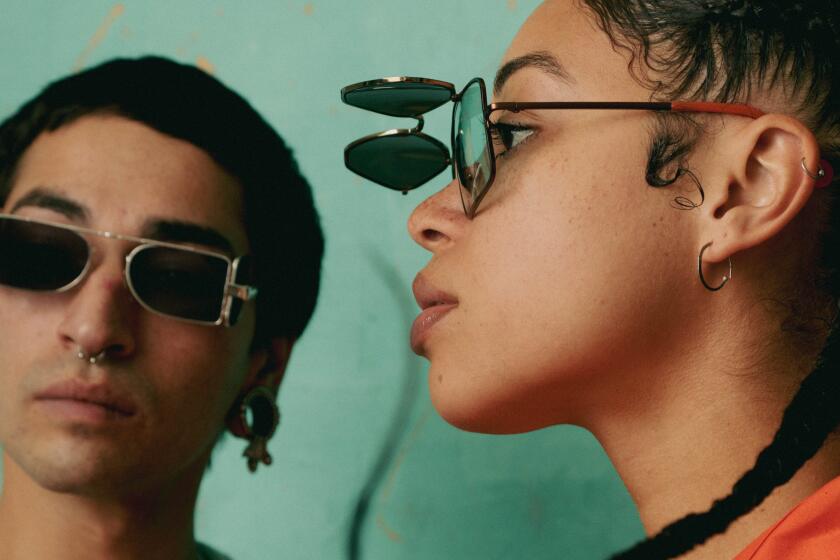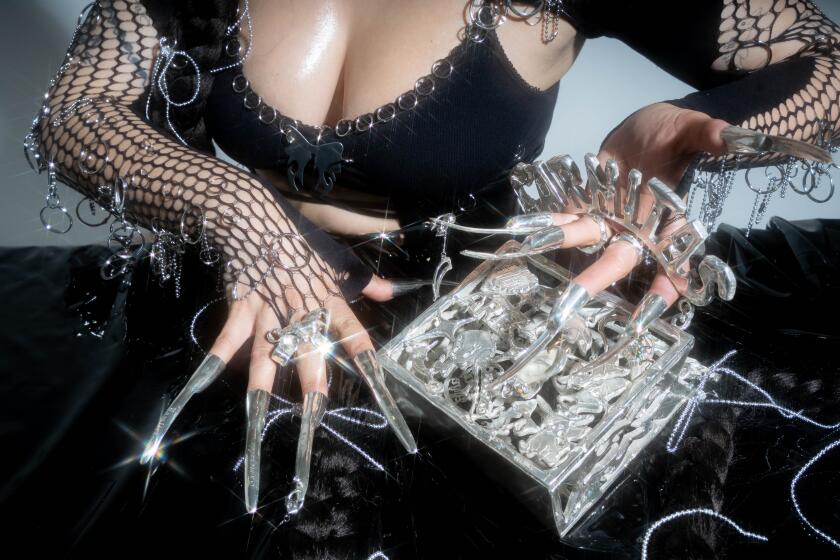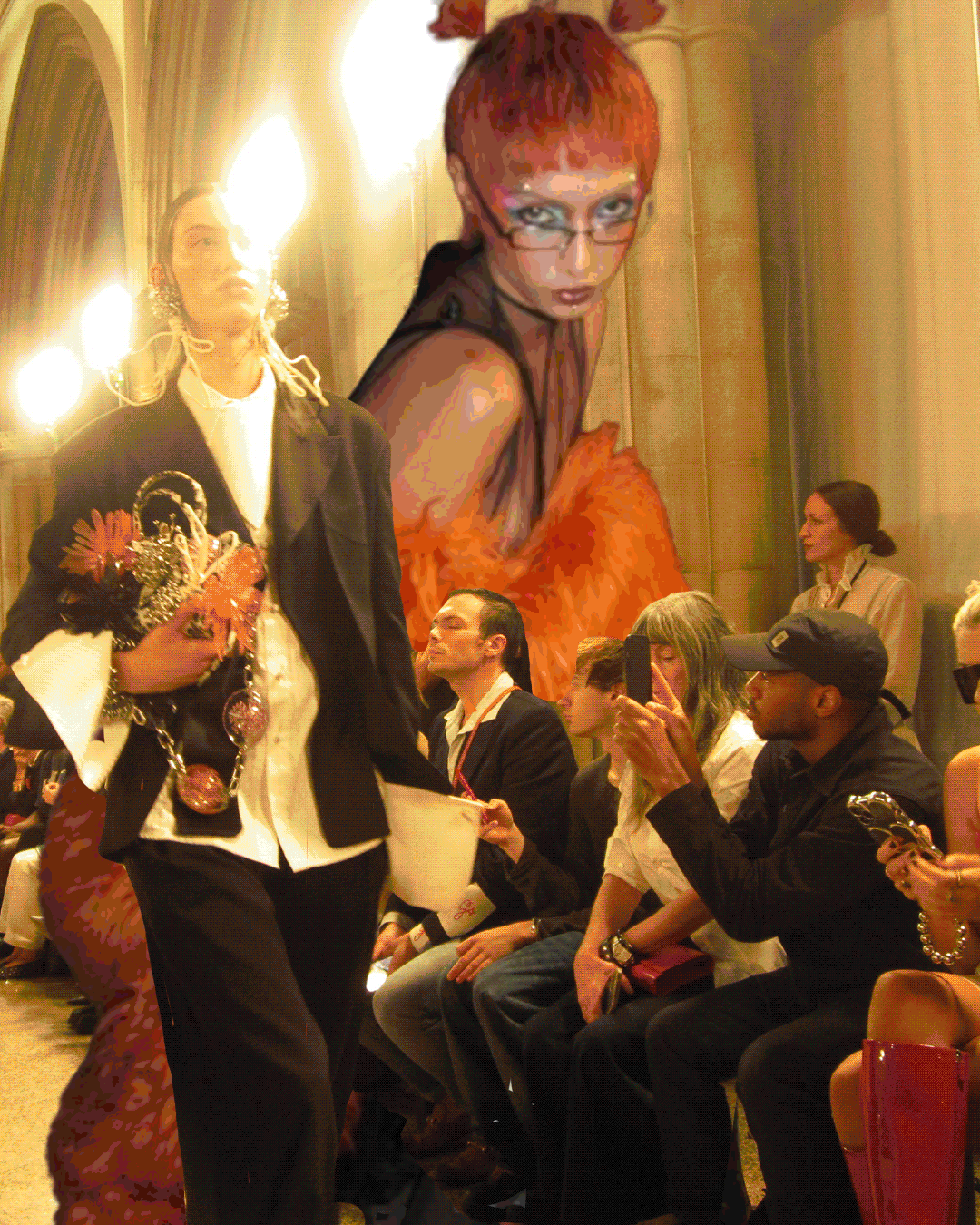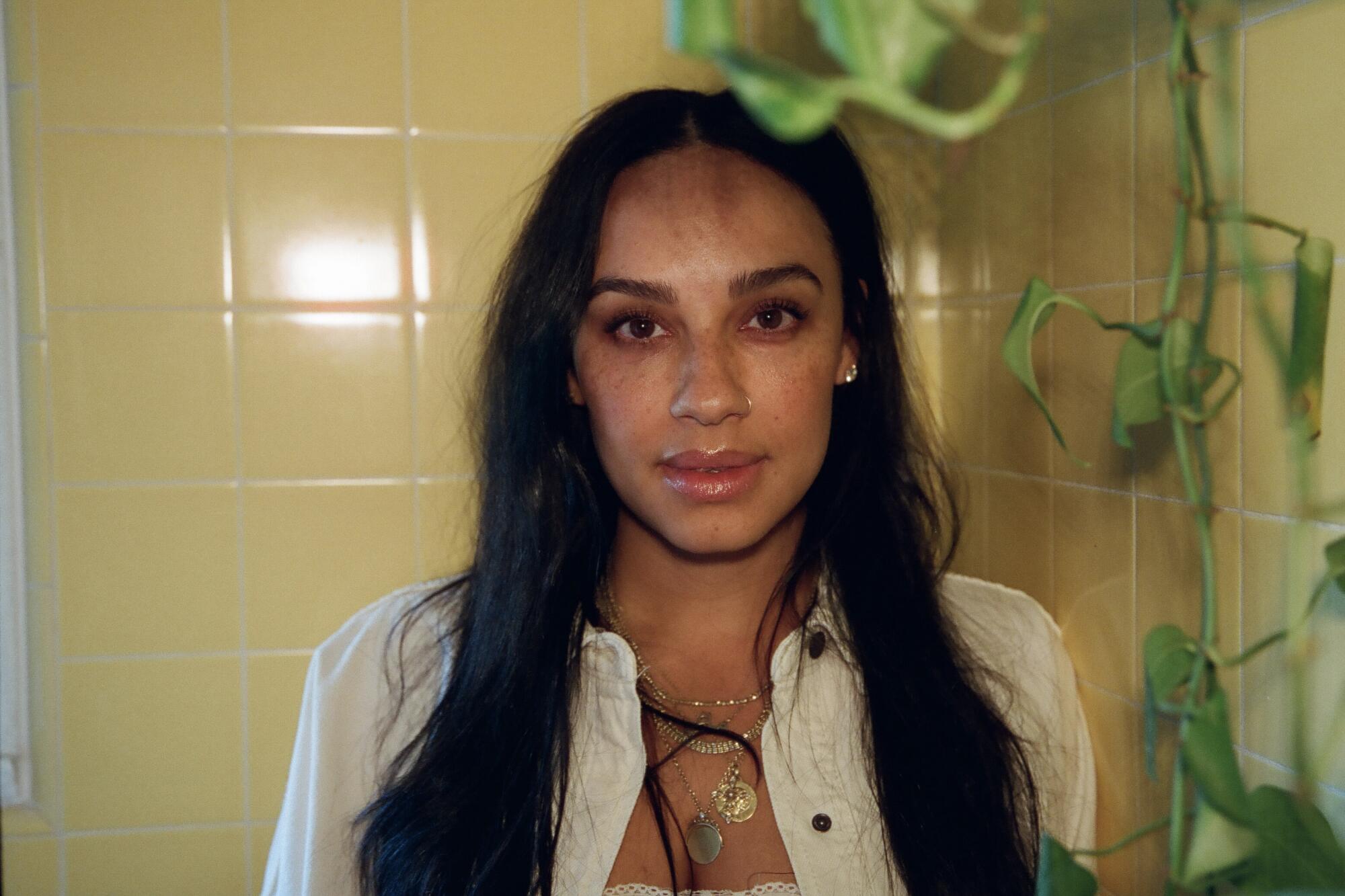
- Share via
This story is part of Image issue 10, “Clarity,” a living document of how L.A. radiates in its own way. Read the full issue here.
For a jewelry designer, Maggi Simpkins doesn’t wear the kind of gaudy jewelry you might expect in a world of Jacob the Jewelers and Johnny Dangs. Sitting in her home in Highland Park, she’s rocking a few delicate gold necklaces and rings. Her style, in general, is very minimalist, understated. We’re talking about the ring, the Sotheby’s piece that has become the stuff of folklore in the luxury jewelry world — maybe you’ve heard of it? — and the wild winter she just made it through, when our convo veers into the waters of L.A. vintage.
As a person who can quite literally make her own jewelry — “ornate things,” as she calls them — Simpkins does like a good vintage piece. She doesn’t have a go-to vintage shop per se, so you can forget the pin you were thinking about dropping now. But the concept of jewelry being passed down is what really gets her going. She loves pieces whose core values are “narrative driven,” she says. “That’s why I like jewelry — it’s not about fancy earrings at Neiman Marcus. It’s my mom’s engagement ring I can wear every single day. I can wear this bracelet. I can tell you a story about my dad — like, this thing that was my grandmother’s. [It’s] the only gold piece of jewelry that I have. I get to be buried in it.
“You can’t wear your favorite shirt every single day. You know? I can then pass these things down generations. They mean things. That’s why I like creating stuff.”
More stories from Clarity
L.A.’s lowrider aficionados explain why the car club plaque serves as a sacred language for the culture.
Anwar Carrots outlines the future of streetwear collabs.
Julissa James gets to the bottom of what an L.A. night really smells like.
Dave Schilling searches for the holy grail of L.A. outerwear.
Georgina Treviño reveals that everything has a little jewelry language in it.
Before last fall, Simpkins was an artist known around L.A. She had done pieces for Kendrick Lamar (before he was Kendrick Lamar), Kendall Jenner and will.i.am, but when the Sotheby’s glow-up happened, suddenly she became one of the most famous emerging designers in the world. Write-ups in Vogue, Harper’s Bazaar, Forbes, the Cut. Billboard and Google commissioned her to make custom necklaces for their Women in Music pendants to be worn by the likes of Doja Cat, Saweetie and Olivia Rodrigo. An office in downtown L.A. And on Instagram, where Simpkins has always shared her work, more people started taking note of her unique pieces.
The attention has only confirmed what she knows to be true: her work is still her work, and she’s good at it. When she started posting her engagement rings, “It just f—ing clicked and it f—ing ignited a fire,” Simpkins says. “And the fire has not stopped burning.”
As an artist, Simpkins has always created from a place of momentum. People make things all the time that don’t motivate them to get out of bed in the morning. But Simpkins makes jewelry that feels infused with purpose. She’s sought out this feeling ever since making an engagement ring for a friend. When he saw it, she remembers, “He lost his breath. Tears, choking up. He was like at a loss.
“This is why I make things — to be a part of these moments and to make people feel things. Like really feel things.”
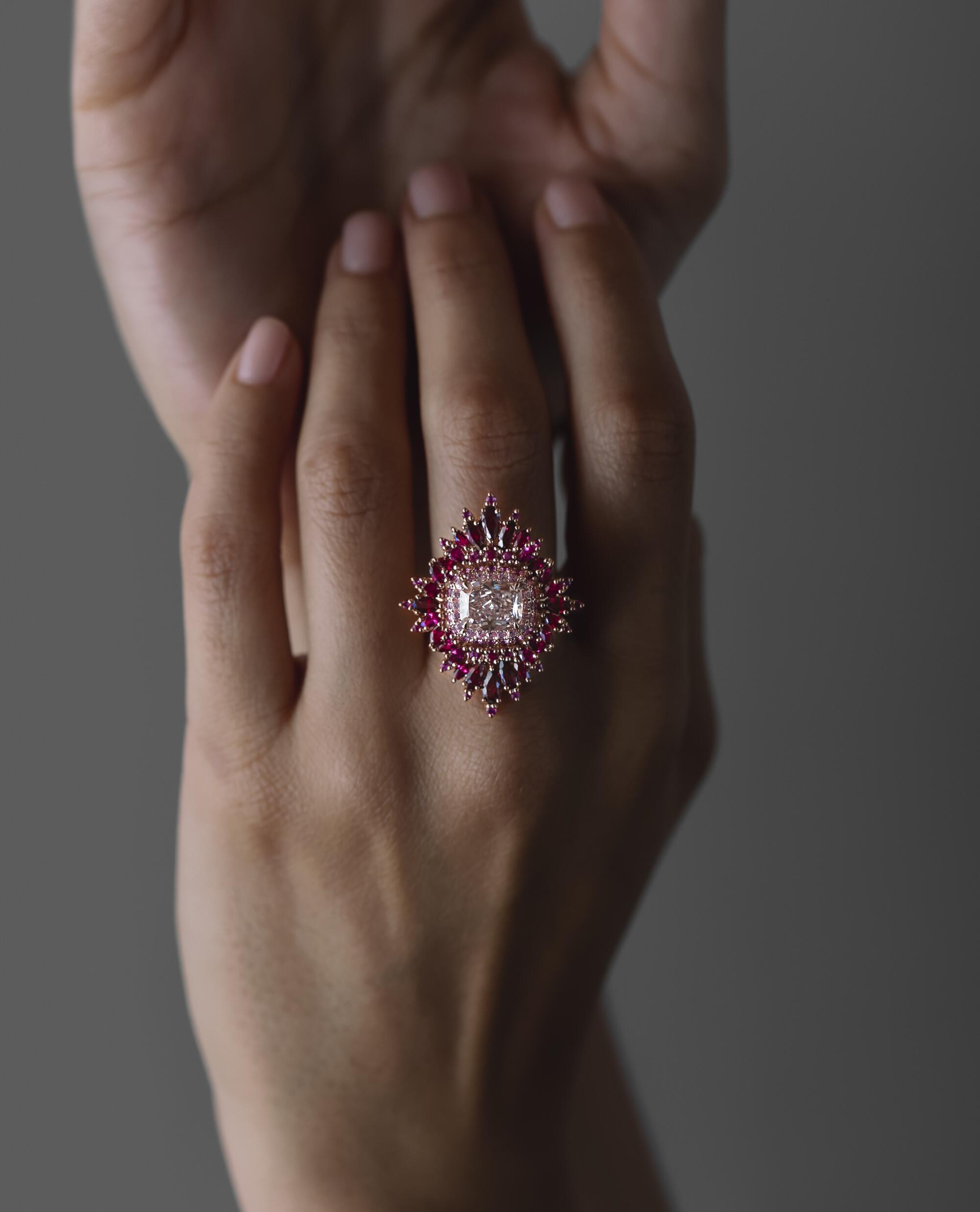
To make that connection through her work, she begins with listening, reading and research. Simpkins looks at jewelry all day long: old, new, contemporary, fashion, bridal. On Instagram, in magazines, on TV. As a person who works with precious stones, her creative work is rooted in raw material. Everything that goes into a custom piece must come from somewhere, after all — a diamond, a gem, gold, silver, dirt.
Simpkins designs each of her rings around the center stone. She likes to start her process with a reference point. “When someone approaches me and they want to create a piece, I encourage them to start looking at jewelry,” she tells me. “I’m trying to understand aesthetically what people’s eyes are drawn to.” After settling on the budget and aesthetic, she goes down the checklist: material sourcing, locking in a deposit, rough sketches and client sign-off, 3-D rendering, printing, gold casting, diamond setting, cleaning, sanding, polishing, appraising. (“For insurance purposes, more than anything.”)
Jewelry design is, like streetwear, a very expensive, high-stakes group project that requires collaboration and communication. Which is why Simpkins makes it a point to work with people she likes. “I just want to create and love, and be in the company of people that I love,” she tells me. “My clients aren’t a—holes. My diamond setters aren’t a—holes. I am not going to sell myself or put myself in a position to be treated like s— for a check. We only have how many hours in the day, right? Let’s spend those hours feeling good. Life’s too short. Don’t have a toxic work environment.”
I just want to create and love, and be in the company of people that I love.
— Maggi Simpkins
The jewelry business is an old industry and jewelry making is an ancient practice, which means there are a lot of elements of craft — ways of doing things — that get passed down through generations. “I’m working with 55-year-old men that are very set in their ways. They’re very old school,” Simpkins says. “It’s generational. People were all born into [this]. Their dads set diamonds and their grandfather set diamonds, you know.
“They’re not people that look like me.”
Simpkins always had a desire to make things. She grew up in inner-city Portland, Ore., to parents who were hippies and artists. Her father was a Black man with long dreadlocks who wore Birkenstocks and drove a Land Rover; he was a boilermaker by trade who welded ships that came into Swan Island and a sculptor who worked with metals. Her white mother was a social worker who had gone to school to become an art teacher. “Both of my parents were really creative, artists that never got to actually be artists,” Simpkins says. “When we talk about being an artist … you didn’t think about it, you just did it. It’s just a part of life.
“My mom made me believe that I could do absolutely anything that I wanted to. I really, really believed that I could do anything. My father marched to the beat of his own drum and didn’t let anyone tell him what was cool.”
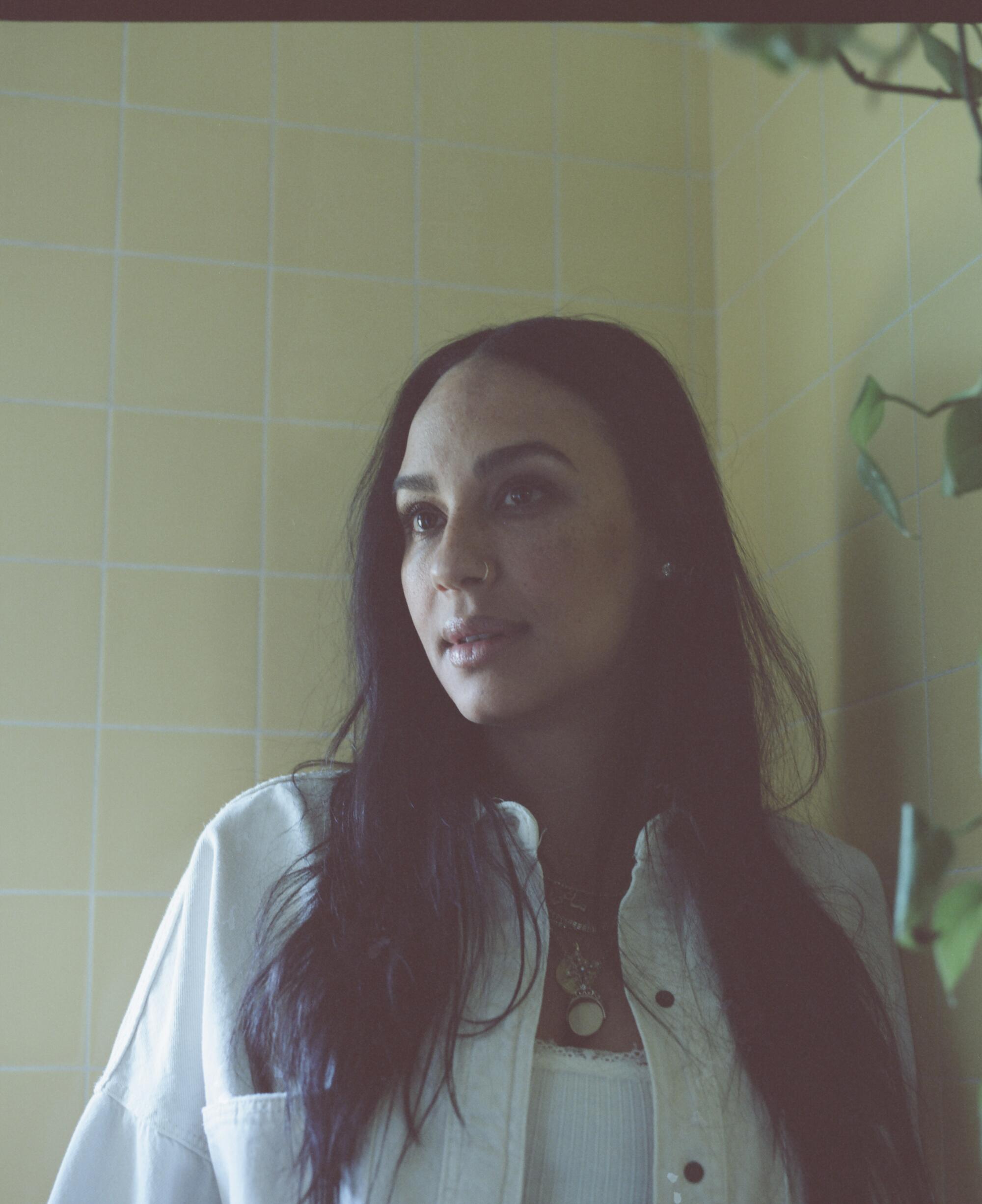
Portland was really white — a fact that Simpkins, as a mixed kid, was hyper-aware of. “I don’t think that there was ever a day when I was younger that I wasn’t aware of race,” she says. “Like it was something that I thought about constantly.” She didn’t have cable growing up (and still is not one for TV). No Nickelodeon or whatever other millennial kids watched. But her mom kept an extra-large loom in the house, which she would use to create textiles. That loom was a source of entertainment for Simpkins. A theater kid, she learned to make outfits in costume design classes. She often made trips to the local Goodwill to get clothes she could cut up and remake.
Simpkins has always had a strong inner voice — a guide that has always been “really tuned in,” she says. She didn’t always know what it meant when it spoke to her, but it was there, hinting that there was something else out there for her to find. One of the first times she listened to it was while at college. She had moved to Los Angeles to attend Loyola Marymount University but hated it and ended up at Santa Monica College, working at Nordstrom on the promenade. “I was like, This is not my life. … This is not making me happy. This is not what I’m supposed to be doing.” So, she blew up her life — quit her job, dropped out of school and broke up with her boyfriend — so she could rebuild.
I am not the modern, modest Muslim lady my mother wanted, nor the good wife my grandfather must have envisioned in a daughter-in-law or granddaughter. The old bling glares and guards me.
“The thing about L.A. is that you have to find your radius,” she says.
On a whim, she reached out to a woman she had met while working at Nordstrom as a personal shopper. Simpkins didn’t know what the woman did for a living but suspected she had some sort of online store that might be good for part-time work. “I’m pretty sure she had a black card,” Simpkins recalls. “Every time she came in, she would drop 2 grand with her eyes closed. … So, I just emailed her.”
Her first day on the job, Simpkins got a peek behind the jewelry showroom curtain. Her boss, who also had an online store, would invite retail brands to look at designs — which were, Simpkins says, sometimes procured from Santee Alley — and then she would fulfill the orders by mass-producing them in China. “My first day of work we needed to send out 2,500 necklaces to BCBG, and it was my job to quality control all 2,500. I was sitting there like, ‘Tag, yes. Tag, no. Tag, yes. Tag, no.’ I looked over in the corner, there was a guy sitting with the scraps that had been tagged ‘no’ — and he was putting them together, playing with the pliers,” she remembers. “Let me tell you. I was like, OK, I know that I said I wanted something. But this is sweatshop vibes. And I’m about to go.”

Simpkins didn’t quit right away but used $45 to buy tools so she could start making her own jewelry on the side. She created a pair of earrings and timidly shared her work with her boss, who agreed to start showing Simpkins’ designs to retailers. Three months later, Nordstrom placed an order “for something I created with my own two hands.”
“That was all my little 20-year-old brain needed,” she says, looking back. “That was the inception of me deciding that I could design jewelry commercially.”
From VidaKush’s princess arm chain to Youth Grillz Paris’ brilliant dental flourishes, a long glistening summer awaits.
After some time with the brand, Simpkins then was offered a $15-an-hour gig helping run a website for an open-to-the-public, wholesale diamond company that was owned by a friend of a friend. Three days a week, she learned the ins and outs of jewelry retail: pulling in leads, customer service, sales, marketing, working with clients, taking custom orders. She peppered the jewelers on staff with questions as they filed waxes. “I was bringing home $1,245,” she remembers, which she supplemented by babysitting, bartending parties, doing whatever she needed to do to pay rent, stay plugged into the Diamond District and buy materials.
“I’d buy saw blades and I’d buy waxes, and I would go home and just work at my little desk, in my little bachelor apartment in a back house in Echo Park, with wax shavings all over the floor.”
Her early work was tribal and geometric. Statement pieces. She’d post pictures on Instagram, and people started to associate her with jewelry. A Hollywood friend asked her to pull some pieces for a Kendrick Lamar music video. She was like, “Who’s Kendrick Lamar? I guess.” She sent it in some Tupperware.
The thing about L.A., is that you have to find your radius.
— Maggi Simpkins
The moment she realized “I can do this” came via Will.i.am. He was making a video and a stylist on the shoot said he wanted to order a piece. This was the first real money she had made outside of her diamond wholesaler job. The moment she saw the 10 grand, it was like she had unlocked a “level of knowing.” “I had this moment where I was like, ‘I’ll always be good. I’ll always be able to do this for myself,’” she says. “You can’t buy that kind of feeling.”
Just as she was on the verge of starting her own business, Simpkins met luxury jewelry designer Ron Hami, who offered her a job in sales. His style was a bit unconventional. But Simpkins credits him as helping her refine her attention to detail; he challenged her to rethink what luxury design means. She went out on her own in 2015.
When she was approached by U.K.-based luxury editor Melanie Grant to be in Sotheby’s’ “Brilliant and Black — A Jewelry Renaissance,” Simpkins was ready to prove to herself what she was made of. “This was very much about me being like, ‘I deserve to be here. Let me show you,’” she says. “Let me prove to you how big and bad and crazy and audacious I can be. And I don’t know. Let me get weird.”
Simpkins designed three rings for a collection she named Permission to Shine. The showstopper piece, Full Bloom, was a brilliant feat of rubies and pink sapphire surrounded by a 2.43-carat diamond. Her mom asked her if she would feel down if it didn’t do well. “That was not the point at all,” she says. “The point was to try and create something that I’ve never created before. And to try and do something that was really f—ing wild.”
Lauren London reflects on acting, Nipsey Hussle, Black L.A.
The thing about arrival is that once you’ve arrived, a new set of choices follows. Your priorities change. You’ve gone through your education, formal or informal. But arrival isn’t always the moment that gets written about. Before Sotheby’s, Simpkins says, “I don’t think that I’ve ever felt the freedom to take risks.” But when the opportunity came up, that calculation changed. “That was like, I’m an independent. Nobody pays attention to a little independent. Pay attention to me. Let me do something crazy,” she says.
“I don’t think that I designed for Maggi today,” she adds. “I think I designed for little Maggi. I love designing decadent, regal, fairy-tale pieces. I feel like that’s a reflection of little Maggi.
“I would like to take more risks.”
More stories from Image
